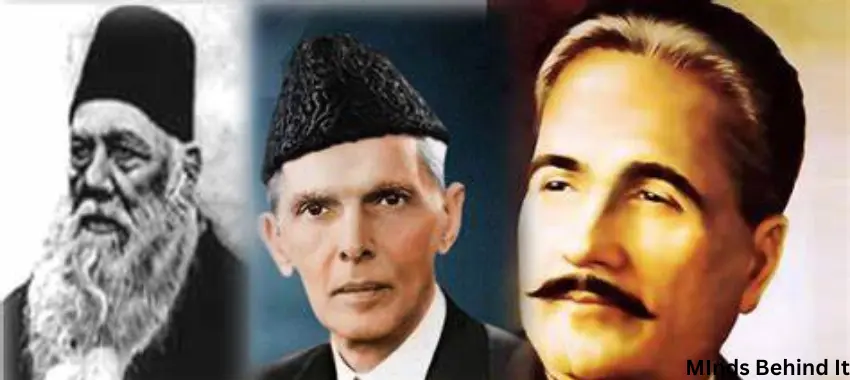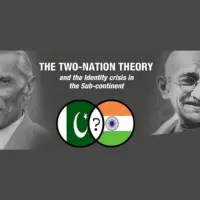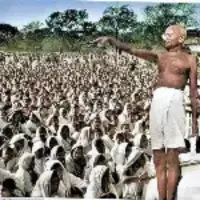Before discussing the two nation theory, let’s first discuss “Nation.” By nation, we mean the birth of a new Ideology, where people of the same religion, having the same values and customs, unite to work on a common goal. Moreover, they also have the same culture and identity, and they unite to share a common geographical location.

What is Two Nation Theory
The partition of the Indian Subcontinent in 1947 was the result of two nation theory. This theory was based on an ideology that demanded a separate homeland for the Indian Muslims. This difference between Hindus and Muslims was based on social, cultural, political, and religious distinctions, which stated that Indian Hindus and Indian Muslims are two separate nations with distinct values and customs.
Based on all the distinctions, the All India Muslim League and Muslim leaders like Quid e Azam demanded a separate homeland and the partition of the Indian Subcontinent into two separate states. They put forth their agenda that the Muslims in the Hindi majority area could not win politically, and they are in danger.
The two nation theory demanded to claim of the western provinces and the Bengal region for the Indian Muslims. They stated that Hindus and Muslims can no longer live together as they are separate from each other in every aspect of life.
There was also some opposition towards the two nation theory, which came from some Muslims and the Hindus; they considered the Indian Subcontinent as a single nation where religious pluralism should be achieved.
Pre-Partition Story
The beginning of Muslim nationalism in the Indian Subcontinent dates back to the first Muslim Invader, i.e., Muhammad Bin Qasim, who conquered some parts of India at that time, and Mahmud of Ghazna opened the preaching gates of Islam through 17 attacks on India. Moreover, there were also several Sufi Saints who played a key role in spreading Islam in the region.
They all presented a picture of Islam which was authentic and pure, which shows that Islam has distinct traditions, values, and customs. These heroes were trying to save the real essence of Islam and prevent any external interference in the teachings of Islam.
Origin of Two Nation Theory

The origin of two nation theory was started by Sir Syed Ahmed Khan and the Aligarh Movement. He was the first who consider Muslims as a separate Nation. Although the British were ruling over the Indians, but 1857 war of independence showed the Muslims of the sub-continent as the rebels. From that day, Muslims were shadowed in every aspect with the help of Hindus.
At that time, the Hindus showed resistance against the Urdu language of the Muslims, which made Sir Syed Ahmed Khan think that Muslims have a separate and distinct identity that has no similarities with the Hindu culture. It is believed that Syed Ahmed Khan was the architect of the two nation theory, and this is evident by his quote that:
“I am convinced now that Hindus and Muslims could never become one nation as their religion and way of life were quite distinct from each other.”
Sir Syed Ahmed Khan was the visionary leader who presented that Muslims are a separate nation and they have the right to live their lives according to their culture and tradition. Sir Syed Ahmed Khan was the one who tried his best to make the Muslims understand that Muslims and Hindus cannot live under one umbrella, as they are separate socially, politically, linguistically, and religiously.
Read More: Pakistan Resolution Day
Factors that led to Two Nation Theory
Religious Separation
Muslims and Hindus are different in the religious sense. Muslims follow only one God, and have the same cultures and traditions; on the other hand, Hindus follow multiple Gods and are divided into various classes. This shows that they cannot be the same at any point.
Educational Disparity
After the War of Independence, the Muslims were being ignored and were not given modern education, while Hindus were given quality education and learning opportunities. This also led to Muslims being neglected in the education sector.
Political Differences
Muslims of that time were being neglected in every political aspect. They felt deprived in the following domains:
- Urdu was written in the Hindi script instead of the Persian script.
- Muslims were oppressed and neglected by the Indian National Congress.
- Annulment of the Partition of Bengal in 1911 showed that only the Indian voice was being heard.
Key Features of Two Nation Theory
The following are the features that are key to note:
Separate Identities
Politically Autonomous
Politically Divided
Social Disparity
Distinct Identities
Separate Homeland
Read More: India and Pakistan Wars and Conflicts
After Sir Syed Ahmed Khan
Although Sir Syed Ahmed Khan initiated the Two Nation Theory, Allama Iqbal and Muhammad Ali Jinnah played a crucial role in upholding the two nation theory. Allama Iqbal presented the ideas through poetry and philosophical stances, while Muhammad Ali Jinnah made them a political reality for a nation.
Role of Muhammad Ali Jinnah
Muhammad Ali Jinnah’s views also resonate with the two-nation theory, and he believed that the coexistence of two separate nations whose identity, culture, and code of life are not the same is not possible. He put this forth by saying that:
“Hindus and Muslims belong to two different religious philosophies, social customs, and literature. They neither intermarry nor interdine together, and indeed they belong to two different civilizations which are based mainly on conflicting ideas and conceptions.”
Presidential Address at the All India Muslim League, Lahore, March 22–23, 1940
He further stated that:
“To yoke together two such nations under a single state, one as a numerical minority and the other as a majority, must lead to growing discontent and final destruction of any fabric that may be so built for the government of such a state.”
Presidential Address, Lahore, 1940
Jinnah’s core message through these quotes was that Muslims and Hindus are distinct nations with their own unique identities, and thus, Muslims deserved a separate homeland to freely practice their religion, culture, and way of life, which eventually led to the creation of Pakistan.
Role of Allama Iqbal in Two Nation Theory
Iqbal believed that Islam is not merely a faith but a complete social system, with its own unique moral, cultural, and political ideals. He argued that Muslims in India were a separate nation, distinct from Hindus, and must be allowed to flourish independently.
Key Quotes & Ideas:
India is a continent of human groups belonging to different races, speaking different languages, and professing different religions. Their behavior is not at all determined by a common racial sentiment. The principle of European democracy cannot be applied to India without recognizing the fact of communal groups. The Muslims are a nation by any definition.”
Allahabad Address, December 29, 1930
In his famous Allahabad Address (1930), Iqbal proposed:
“I would like to see the Punjab, North-West Frontier Province, Sindh, and Baluchistan amalgamated into a single state. Self-government within the British Empire, or without the British Empire, the formation of a consolidated North-West Indian Muslim State appears to me to be the final destiny of the Muslims, at least of North-West India.”
This was perhaps the first formal expression of a separate Muslim homeland — the ideological foundation for Pakistan.
On Islamic Identity:
“Islam is not a mere faith; it is a cultural, social, and political system too.”
Iqbal believed that Muslims could not live under a system dominated by Hindu-majority values, as it would threaten their religious freedom and cultural identity.
Conclusion
In conclusion, the Two Nation Theory emerged as a powerful ideological foundation that reshaped the destiny of the Indian subcontinent. Rooted in the belief that Muslims and Hindus were two distinct nations with irreconcilable religious, cultural, social, and political differences, it became the driving force behind the demand for a separate Muslim homeland. Visionary leaders like Sir Syed Ahmed Khan, Allama Iqbal, and Muhammad Ali Jinnah played pivotal roles in articulating, advocating, and transforming this ideology into a political movement.
While Sir Syed Ahmed Khan laid the intellectual groundwork by highlighting the cultural and religious distinctions between Muslims and Hindus, Allama Iqbal provided the philosophical and ideological depth to the concept, envisioning a separate state where Muslims could live in accordance with their values and faith. Finally, Muhammad Ali Jinnah translated these ideas into political reality, leading to the creation of Pakistan in 1947.
Though the Two Nation Theory faced resistance from various quarters, it undeniably altered the course of South Asian history. It established the principle that nations are not solely defined by geographical boundaries but also by shared faith, values, culture, and identity. The creation of Pakistan stands today as a testament to the enduring impact of this theory on the geopolitical and cultural landscape of the region.
Frequently Asked Questions
Who was the first person to propose the idea of the Two-Nation Theory?
Sir Syed Ahmed Khan was the first to formally propose the idea by emphasizing the distinct religious, cultural, and social identities of Muslims and Hindus in the subcontinent.
What was the significance of Allama Iqbal’s Allahabad Address in 1930?
In his Allahabad Address, Allama Iqbal clearly demanded a separate Muslim state in North-Western India, laying the ideological foundation for the creation of Pakistan.
How did Muhammad Ali Jinnah contribute to the Two-Nation Theory?
Muhammad Ali Jinnah turned the ideological concept into a political movement, advocating for a separate Muslim homeland through his leadership of the All India Muslim League, which ultimately led to Pakistan’s creation in 1947.











